Planning Emergency Shelters for Urban Disaster Resilience: An Integrated Location-Allocation Modeling Approach
Abstract
:1. Introduction
2. Literature Review
2.1. Urban Resilience
2.2. Shelter Demand Estimation
2.3. Shelter Site Location
3. Model Formulation
3.1. Time-Varying Shelter Demand
3.2. The Integrated Location-Allocation Model
- The population of a given community is concentrated at its central point (i.e., we use a “center of mass” approach to calculate travel distances between a community and a shelter).
- The evacuees follow the government’s recommended paths when they evacuate to an assigned shelter.
- Evacuees evacuate to an assigned shelters on foot, so the condition of major routes has little effect on the evacuees’ choice of shelters.
- The physical locations of all candidate shelters are predetermined.
- All residents of a given community are assigned to only one shelter in order to avoid confusion during evacuation.
- Distance constraint: To ensure safety, it is necessary for evacuees to reach a nearby shelter within a short time after the disaster. Hence, the distance between each community and its assigned shelter should be within the shelter’s maximum service radius. This is the most important constraint and therefore has higher priority.
- Capacity constraint: For a shelter to meet the basic needs for living, the number of people in a shelter should not exceed the shelter’s maximum capacity.
4. Solution Procedure
4.1. CE-Based Solution Approach
4.2. Local Search Heuristic
- Calculate the performance value of the initial solution.If the initial allocation solution produces the positive penalty, then the performance value of the initial solution is computed using Equation (20).
- Improve the performance of the initial solution.Two “greedy” local search approaches (“insert” and “swap”) are applied to improve the initial solution. For each current solution, the entire neighbourhood is exploited. Hence, the best move is the one, over all possible moves, that provides the largest improvement. The insert is performed on the solution, followed by the swap. The insert operation is designed to move a community from one open shelter to another open shelter. As shown in Figure 4, demand i can be reassigned to one of two other shelters. The swap operation is designed to switch shelters for two communities. For example, in Figure 5, community j is assigned to shelter 1 and community k is assigned to shelter 2. After the swap move, communities j and k switch their shelters.
- Output the allocation solutions.Repeat the insert and swap moves in Step 2 until the solution cannot be further improved by the local search.
4.3. Overall Solution Procedure
- Initialization.
- (a)
- Set the values of the parameters: N, , , (the maximum number of iterations, which usually is no more than 30), and (a s-dimensions vector is usually equal to ).
- (b)
- Let .
- Generate a sample population .
- , .
- Construct solutions.
- (a)
- Select the shelter location from the candidate sites.
- (b)
- Allocate shelter demand to the selected shelters location.
- (c)
- Apply the local search heuristic to improve the allocation of solutions with a positive penalty value.
- (d)
- .
- If , go to Step 6. Otherwise, go to Step 4.
- Sort Y in ascending order with respect to the performance function value. Select the best solutions from the sample population.
- Compute using Equation (18).
- If , or converges, output the best solution and the corresponding allocation and stop. Otherwise, return to Step 2.
5. Results and Discussion
5.1. Study Area
5.2. Data Preprocessing
5.3. Results and Analysis
5.4. Discussion
6. Conclusions
Acknowledgments
Author Contributions
Conflicts of Interest
References
- Altay, N.; Green, W.G., III. OR/MS research in disaster operations management. Eur. J. Oper. Res. 2006, 175, 475–493. [Google Scholar] [CrossRef]
- Galindo, G.; Batta, R. Review of recent developments in OR/MS research in disaster operations management. Eur. J. Oper. Res. 2013, 230, 201–211. [Google Scholar] [CrossRef]
- Klein, R.J.T.; Nicholls, R.J.; Thomalla, F. Resilience to natural hazards: How useful is this concept? Glob. Environ. Chang. Part B Environ. Hazards 2003, 5, 35–45. [Google Scholar] [CrossRef]
- Meerow, S.; Newell, J.P.; Stults, M. Defining urban resilience: A review. Landsc. Urban Plan. 2016, 147, 38–49. [Google Scholar] [CrossRef]
- Romero-Lankao, P.; Gnatz, D.M.; Wilhelmi, O.; Hayden, M. Urban Sustainability and Resilience: From Theory to Practice. Sustainability 2016, 8, 1224. [Google Scholar] [CrossRef]
- Bozza, A.; Asprone, D.; Fabbrocino, F. Urban Resilience: A Civil Engineering Perspective. Sustainability 2017, 9, 103. [Google Scholar] [CrossRef]
- Kulshrestha, A.; Wu, D.; Lou, Y.; Yin, Y. Robust Shelter Locations for Evacuation Planning with Demand Uncertainty. J. Transp. Saf. Secur. 2011, 3, 272–288. [Google Scholar] [CrossRef]
- Verma, A.; Gaukler, G.M. Pre-positioning disaster response facilities at safe locations: An evaluation of deterministic and stochastic modeling approaches. Comput. Oper. Res. 2015, 62, 197–209. [Google Scholar] [CrossRef]
- Yin, Z.; Li, S.; Zhao, Z.; Yang, S. Earthquake disaster forecast and earthquake disaster rank. China Earthq. 1991, 7, 9–19. (In Chinese) [Google Scholar]
- Khazai, B.; Daniell, J.; Franchin, P.; Cavalieri, F.; Vangelsten, B.; Lervolino, L.; Esposito, S. A New Approach to Modeling Post-Earthquake Shelter Demand: Integrating Social Vulnerability in Systemic Seismic Vulnerability Analysis. In Proceedings of the 15th World Conference on Earthquake Engineering, Lisbon, Portugal, 24–28 September 2012; pp. 2105–2115. [Google Scholar]
- Wang, J.; Zhao, L.; Wang, K.; Ma, T.; Ni, J. Necessity Analysis and Human Factor Aspect in Building Emergency Shelters for Earthquake Disasters. Ind. Eng. J. 2013, 1, 9–24. (In Chinese) [Google Scholar]
- Johnson, C. Strategic planning for post-disaster temporary housing. Disasters 2007, 31, 435–458. [Google Scholar] [CrossRef] [PubMed]
- Liu, Q.; Ruan, X.; Shi, P. Selection of emergency shelter sites for seismic disasters in mountainous regions: Lessons from the 2008 Wenchuan Ms 8.0 Earthquake, China. J. Asian Earth Sci. 2011, 40, 926–934. (In Chinese) [Google Scholar] [CrossRef]
- Owen, S.H.; Daskin, M.S. Strategic facility location: A review. Eur. J. Oper. Res. 1998, 111, 423–447. [Google Scholar] [CrossRef]
- Daskin, M.S. Network and Discrete Location: Models, Algorithms, and Applications; John Wiley & Sons: New York, NY, USA, 1995. [Google Scholar]
- Alçada-Almeida, L.; Tralhão, L.; Santos, L.; Coutinho-Rodrigues, J. A Multiobjective Approach to Locate Emergency Shelters and Identify Evacuation Routes in Urban Areas. Geogr. Anal. 2009, 41, 9–29. [Google Scholar] [CrossRef]
- Huang, R.; Kim, S.; Menezes, M. Facility location for large-scale emergencies. Ann. Oper. Res. 2010, 181, 271–286. [Google Scholar] [CrossRef]
- Murali, P.; Ordóñez, F.; Dessouky, M.M. Facility location under demand uncertainty: Response to a large-scale bio-terror attack. Socio-Econ. Plan. Sci. 2012, 46, 78–87. [Google Scholar] [CrossRef]
- Li, A.C.; Nozick, L.; Xu, N.; Davidson, R. Shelter location and transportation planning under hurricane conditions. Transp. Res. Part E Logist. Transp. Rev. 2012, 48, 715–729. [Google Scholar] [CrossRef]
- Gutjahr, W.J.; Dzubur, N. Bi-objective bilevel optimization of distribution center locations considering user equilibria. Transp. Res. Part E Logist. Transp. Rev. 2016, 85, 1–22. [Google Scholar] [CrossRef]
- Chen, Z.; Chen, X.; Li, Q.; Chen, J. The temporal hierarchy of shelters: A hierarchical location model for earthquake-shelter planning. Int. J. Geogr. Inf. Sci. 2013, 27, 1612–1630. [Google Scholar] [CrossRef]
- Paul, J.A.; MacDonald, L. Location and capacity allocations decisions to mitigate the impacts of unexpected disasters. Eur. J. Oper. Res. 2016, 251, 252–263. [Google Scholar] [CrossRef]
- Huang, B.; Liu, N.; Chandramouli, M. A GIS supported Ant algorithm for the linear feature covering problem with distance constraints. Decis. Support Syst. 2006, 42, 1063–1075. [Google Scholar] [CrossRef]
- Saadatseresht, M.; Mansourian, A.; Taleai, M. Evacuation planning using multiobjective evolutionary optimization approach. Eur. J. Oper. Res. 2009, 198, 305–314. [Google Scholar] [CrossRef]
- Ng, M.; Park, J.; Waller, S.T. A Hybrid Bilevel Model for the Optimal Shelter Assignment in Emergency Evacuations. Comput. Aided Civ. Infrastruct. Eng. 2010, 25, 547–556. [Google Scholar] [CrossRef]
- Kılcı, F.; Kara, B.Y.; Bozkaya, B. Locating temporary shelter areas after an earthquake: A case for Turkey. Eur. J. Oper. Res. 2015, 243, 323–332. [Google Scholar] [CrossRef]
- Pérez-Galarce, F.; Canales, L.J.; Vergara, C.; Candia-Véjar, A. An optimization model for the location of disaster refuges. Socio-Econ. Plan. Sci. 2017, 59, 56–66. [Google Scholar] [CrossRef]
- Wright, K.; Johnston, D. Post-earthquake sheltering needs: How loss of structures and services affects decision making for evacuation. In Proceedings of the 2010 New Zealand Society for Earthquake Engineering Conference, Wellington, New Zealand, 26–28 March 2010; pp. 21–23. [Google Scholar]
- Sheu, J.B.; Pan, C. A method for designing centralized emergency supply network to respond to large-scale natural disasters. Transp. Res. Part B Methodol. 2014, 67, 284–305. [Google Scholar] [CrossRef]
- Rubinstein, R. The Cross-Entropy Method for Combinatorial and Continuous Optimization. Methodol. Comput. Appl. Probab. 1999, 1, 127–190. [Google Scholar] [CrossRef]
- Caserta, M.; Rico, E.Q. A Cross Entropy-Based Metaheuristic Algorithm for Large-Scale Capacitated Facility Location Problems. J. Oper. Res. Soc. 2009, 60, 1439–1448. [Google Scholar] [CrossRef]
- De Boer, P.T.; Kroese, D.; Mannor, S.; Rubinstein, R. A Tutorial on the Cross-Entropy Method. Ann. Oper. Res. 2005, 134, 19–67. [Google Scholar] [CrossRef]
- Gismondi, M.; Huisman, O. Spatio-temporal behaviour after an earthquake: A case study of Kawaguchi town, Japan. Disaster Prev. Manag. Int. J. 2012, 21, 370–385. [Google Scholar] [CrossRef]
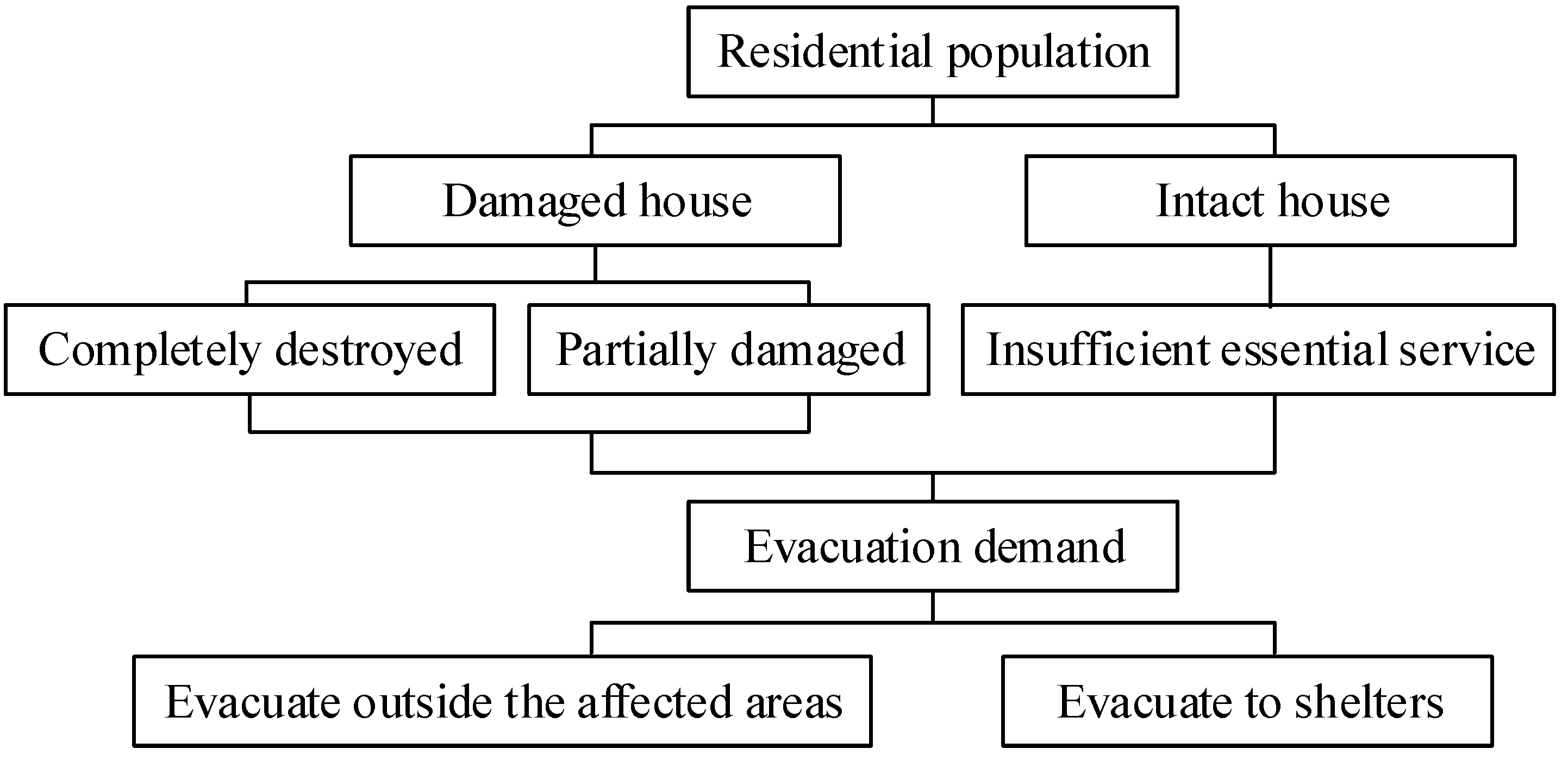

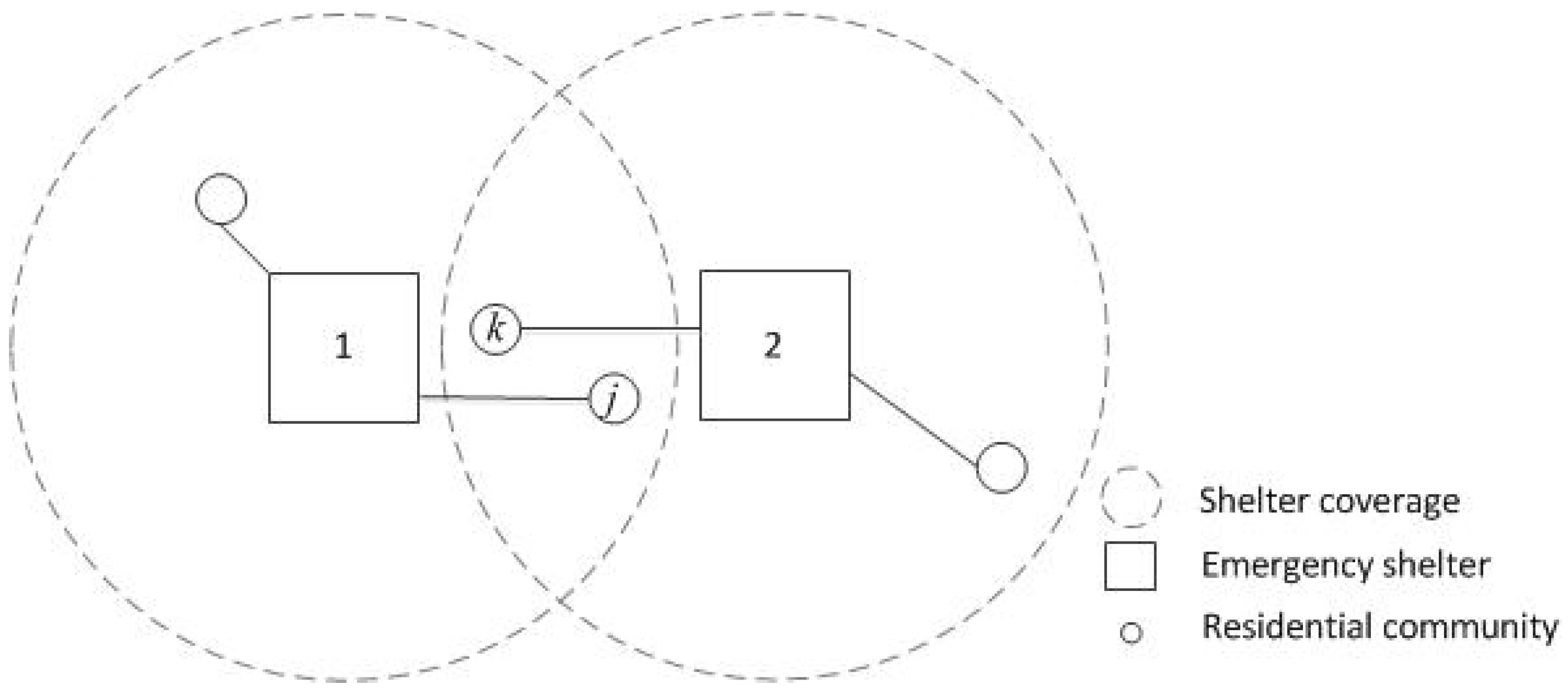
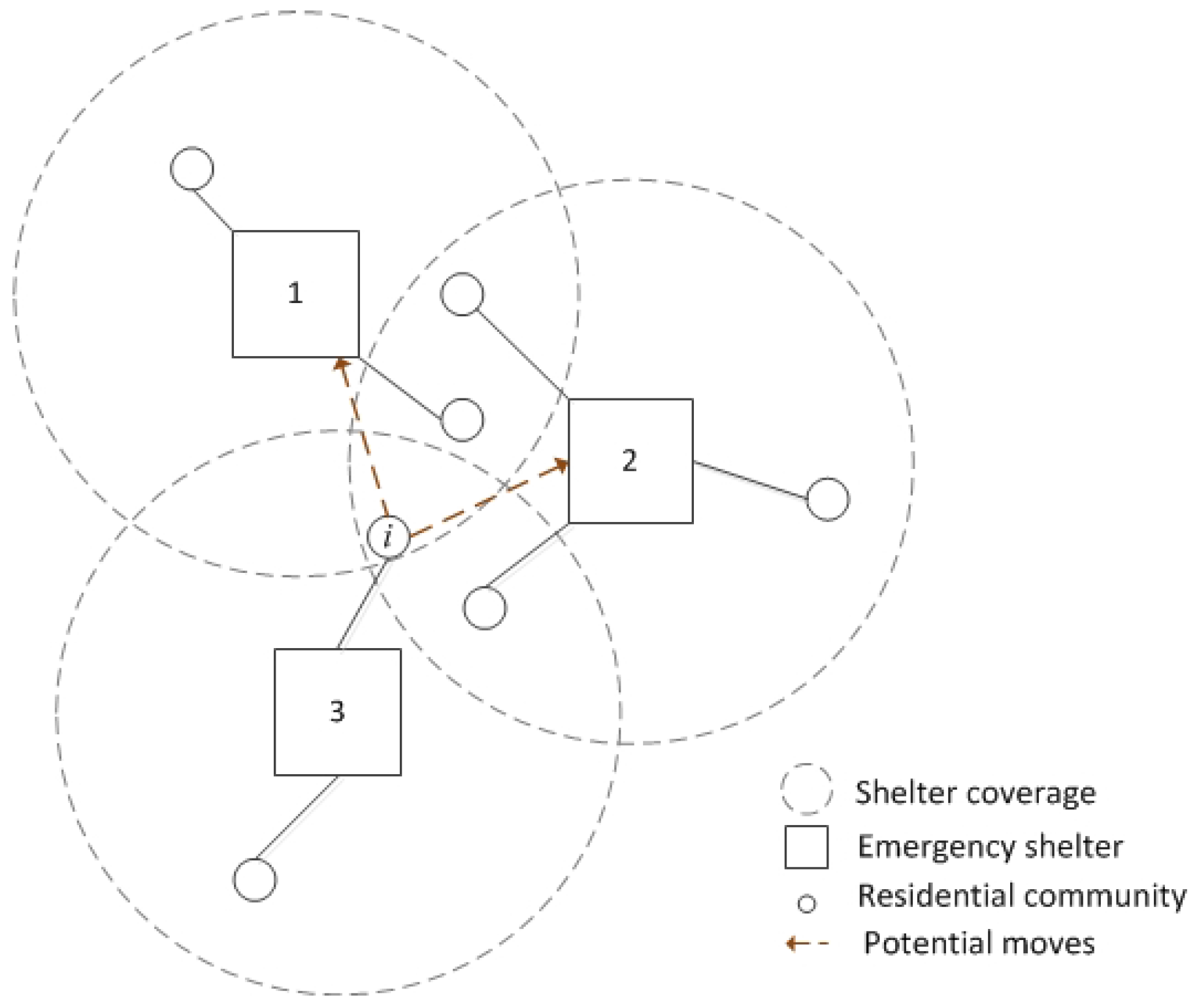

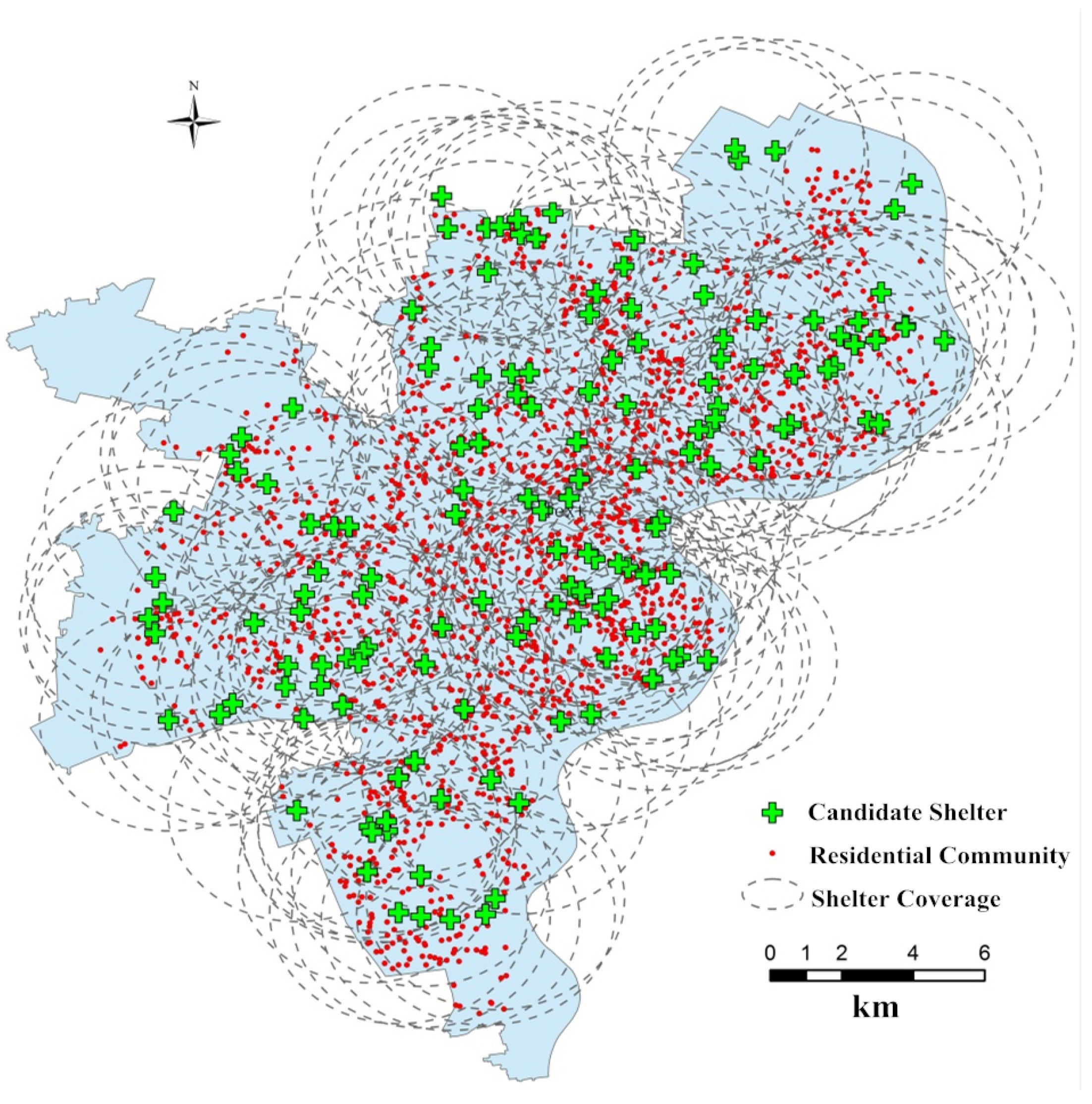
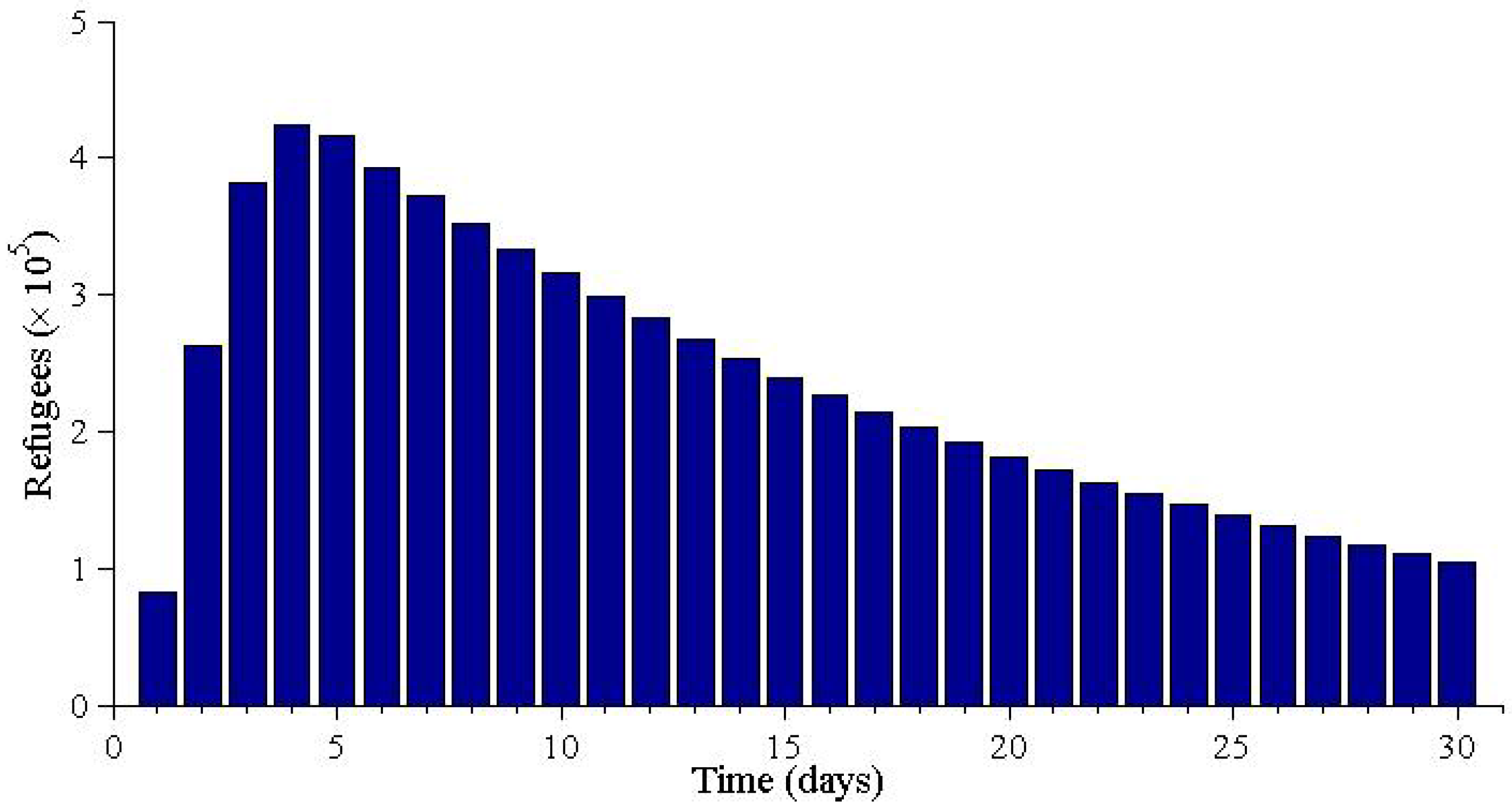
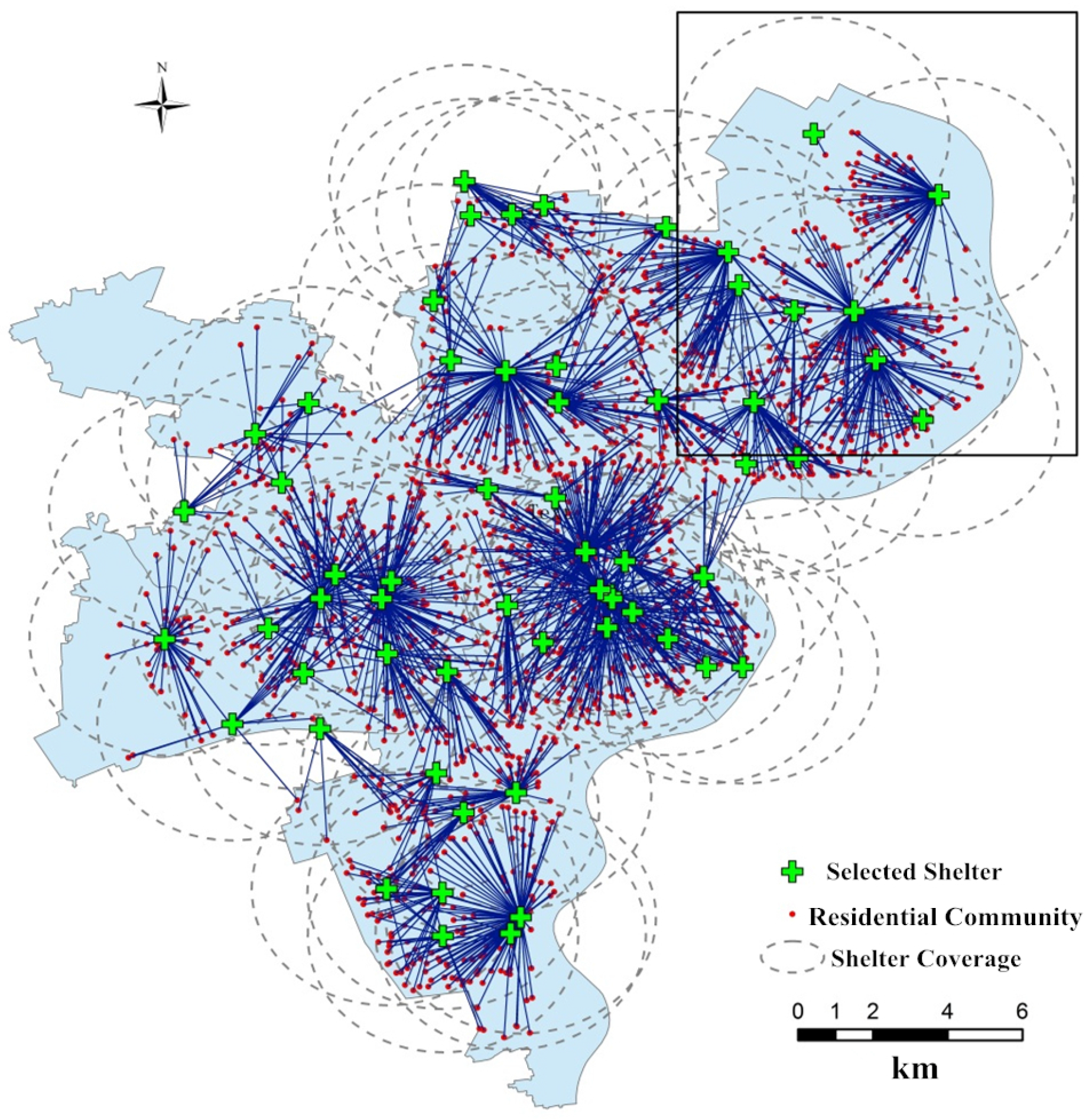
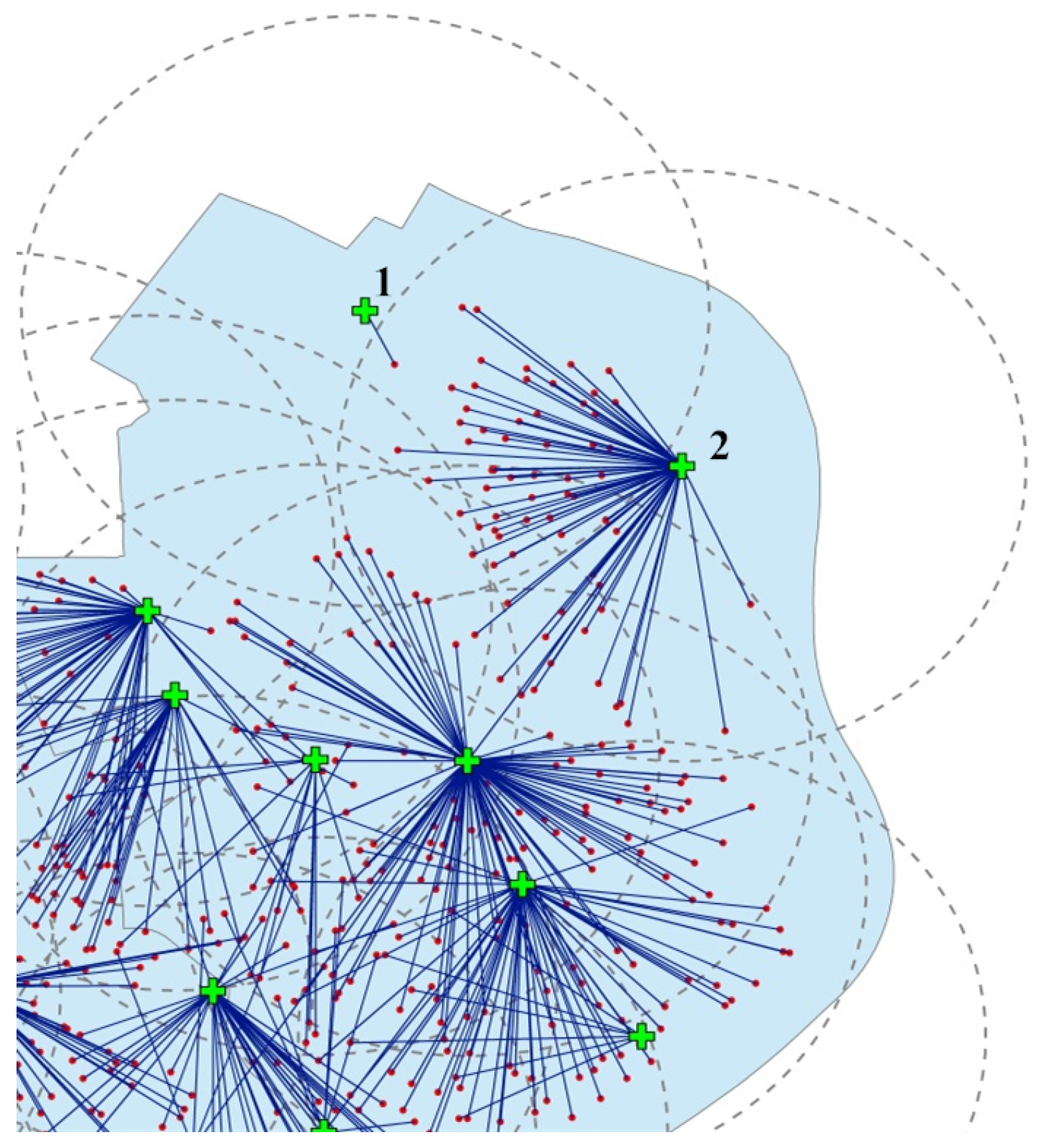

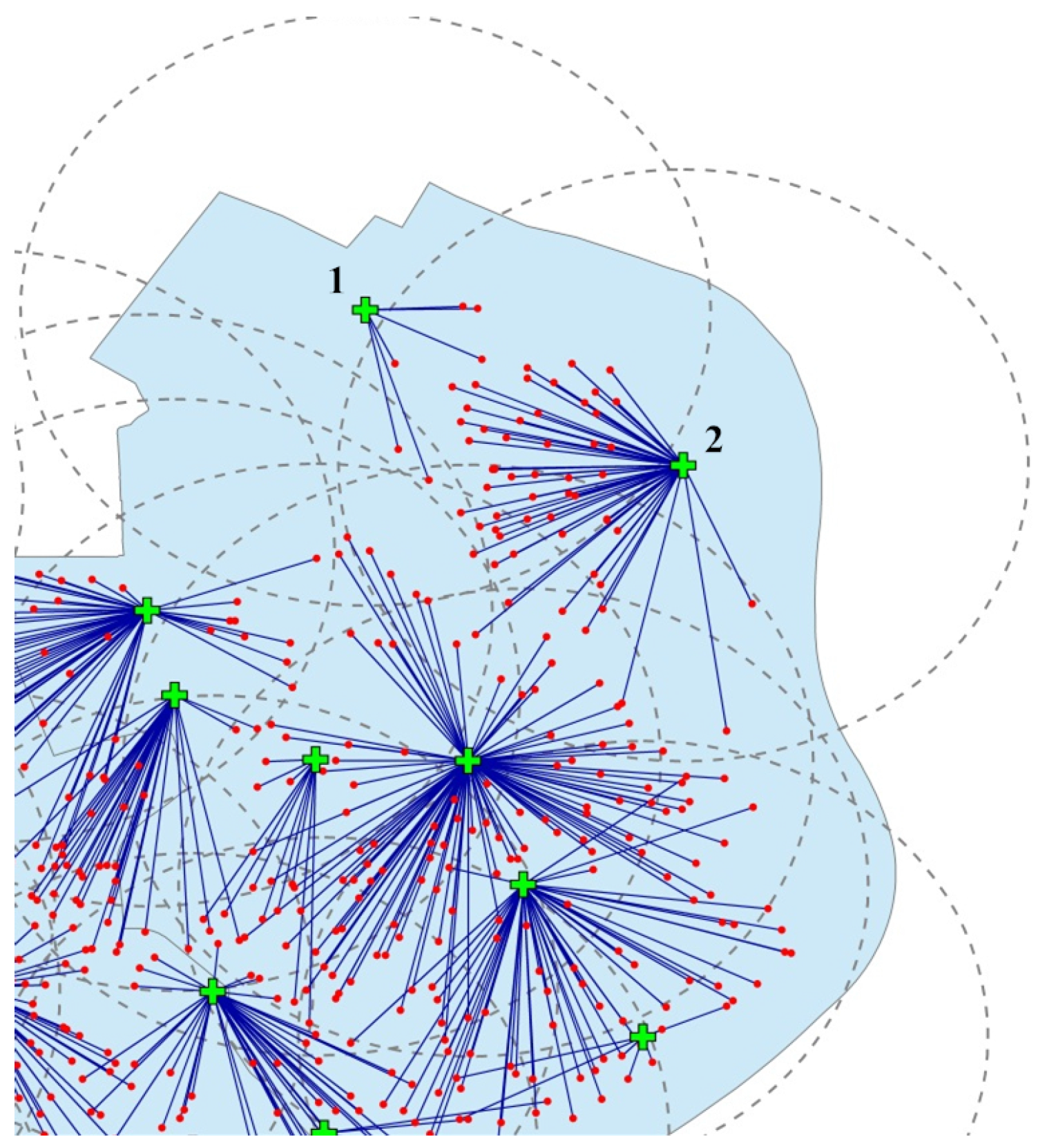
| Type | Capacity ( Persons) | Setup Cost ( USD) |
|---|---|---|
| Public parks/green spaces | ≤10 | 6.7 |
| (10, 30] | 8.3 | |
| (30, 50] | 10 | |
| ≥50 | 13 | |
| Schools | ≤5 | 3.3 |
| (5, 15] | 5 | |
| (15, 20] | 6.7 | |
| ≥20 | 8.3 |
| Type | Construtction Cost ( USD) | Evacuation Distance (km) | |||
|---|---|---|---|---|---|
| Low seismic resistance | = 0.85 | 55 | 3,246,485 | ||
| = 2.5 | |||||
| = 0.2 | |||||
| = 4 | |||||
| High seismic resistance | = 0.95 | 39 | 2,384,532 | ||
| = 1.5 | |||||
| = 0.1 | |||||
| = 3 |
© 2017 by the authors. Licensee MDPI, Basel, Switzerland. This article is an open access article distributed under the terms and conditions of the Creative Commons Attribution (CC BY) license (http://creativecommons.org/licenses/by/4.0/).
Share and Cite
Zhao, L.; Li, H.; Sun, Y.; Huang, R.; Hu, Q.; Wang, J.; Gao, F. Planning Emergency Shelters for Urban Disaster Resilience: An Integrated Location-Allocation Modeling Approach. Sustainability 2017, 9, 2098. https://doi.org/10.3390/su9112098
Zhao L, Li H, Sun Y, Huang R, Hu Q, Wang J, Gao F. Planning Emergency Shelters for Urban Disaster Resilience: An Integrated Location-Allocation Modeling Approach. Sustainability. 2017; 9(11):2098. https://doi.org/10.3390/su9112098
Chicago/Turabian StyleZhao, Laijun, Huiyong Li, Yan Sun, Rongbing Huang, Qingmi Hu, Jiajia Wang, and Fei Gao. 2017. "Planning Emergency Shelters for Urban Disaster Resilience: An Integrated Location-Allocation Modeling Approach" Sustainability 9, no. 11: 2098. https://doi.org/10.3390/su9112098
APA StyleZhao, L., Li, H., Sun, Y., Huang, R., Hu, Q., Wang, J., & Gao, F. (2017). Planning Emergency Shelters for Urban Disaster Resilience: An Integrated Location-Allocation Modeling Approach. Sustainability, 9(11), 2098. https://doi.org/10.3390/su9112098




